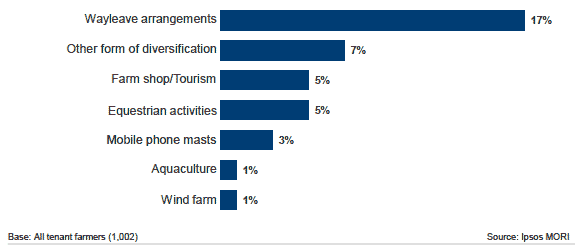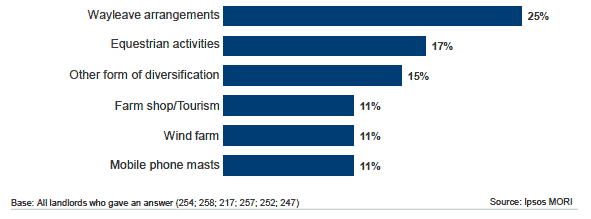Views of Tenant Farmers and Agricultural Landlords on Aspects of the Agricultural Tenancy System
Results from surveys of tenant farmers and agricultural landlords on aspects of the tenancy system such as rent review, fixed equipment, diversification and tenancy relationships.
5 DIVERSIFICATION
Summary
1. Thirty per cent of tenant farmers have some kind of diversification activity on their farm business. The most common form of diversification for tenants to report was wayleave arrangements on the land (reported by 17%). A quarter of landlords who responded reported wayleave arrangements on land that they rent-out.
2. The majority of tenant farmers and landlords who reported that there was diversification on the tenancy reported that they had not received a Scotland Rural Development Programme (SRDP) or capital grant to fund the activity.
3. The majority of tenant farmers reported that they had sole-funded any diversification on their tenanted farm.
5.1 This section discusses issues related to diversification of tenanted farms. It looks at the nature of diversification activities, how these activities were funded, and at issues around landlords' consent for such activities.
5.2 Respondents were asked if their farm business included a number of diversification activities: aquaculture; equestrian activities; farm shop/tourism; mobile phone masts; wayleave arrangements (which include payment for having utility pipes or cables through the land); wind farm; or any other type of diversification.
5.3 While the majority of tenant farmers did not have any of these diversification activities on their land[16], 30% reported that they had some form of diversification. The most common type of diversification was wayleave arrangements (17%). Other types of diversification were reported by less than 10% of tenant farmers (Figure 5.1).
Figure 5.1: Diversification on land rented-in
Q. Do you have any of the following on any land you rent?

5.4 There were some differences in the likelihood of tenant farmers to report diversification on their land, by farm type. Those on arable farms (29%) and livestock farms of over 80 hectares (22%) were more likely than tenant farmers on 'other' farm types (14%), and livestock farms of less than 80 hectares (9%) to have wayleave arrangements.
5.5 Similarly, tenant farmers on livestock farms of over 80 hectares were more likely to have mobile phone masts (6%) or farm shop/tourism (8%) on their land than those on livestock farms of under 80 hectares (1% and 1% respectively).
5.6 Tenant farmers on mixed (9%), arable (9%) or other types of farms (6%) were more likely to have equestrian activities on their land than those with livestock farms under 80 hectares (2%).
5.7 Agricultural landlords were asked if they had ever received a request from any of their tenants to carry out a diversification activity on the land that they rent-out. Thirty per cent said that they had received such a request, and 64% had not received a request. Forty-six per cent of landlords were found to have a diversification activity on the land that they rent-out, with 54% of landlords having no diversification activity on their land.
5.8 Similar to tenant farmers, 25% of landlords reported that there were wayleave arrangements on their land. The next most commonly-reported diversification activity was equestrian activities (17%) (Figure 5.2).
Figure 5.2: Diversification on land rented-out
Q. Have any of the following been developed with your agreement on land that you lease out?

5.9 Tenant farmers who reported that their farm includes a diversification activity were asked if the activity was subject to a separate lease outwith their tenancy. As shown in table 5.1, it was more common for diversification to be included on the same lease as the tenancy, except in the case of mobile phone masts, with 21 of 31 tenant farmers with this type of diversification on their land, reporting that these were subject to a separate lease from their tenancy. As can be seen, the number of tenant farmers in the sample who have a diversification activity on their land tends to be small.
Table 5.1: Diversification and separate leases on land rented by tenant farmers[17]
Q. Is the diversification activity subject to a separate lease outwith your tenancy?
| Yes | No | Don't know/ N/A | Base | |
|---|---|---|---|---|
| Mobile phone masts | 21 | 7 | *[18] | 31 |
| Aquaculture | * | 6 | 0 | 10 |
| Wind farm | * | 6 | * | 11 |
| Wayleave arrangements | 27% | 66% | 7% | 179 |
| Equestrian activities | 21% | 79% | 0% | 50 |
| Other form of diversification | 19% | 81% | 0% | 82 |
| Farm shop/tourism | 15% | 69% | 15% | 52 |
5.10 Fifty-nine per cent of landlords who answered, reported that none of the diversification activities on the land they rent-out are covered by a separate lease, while 17% said that some of these activities were covered by a separate lease, and 15% that all of these activities were subject to a separate lease.
Sources of funding for diversification
5.11 A number of questions looked at sources of funding for diversification activities. When asked if there had been receipt of an Scotland Rural Development programme (SRDP) or other capital grant, half of the ten tenant farmers who had aquaculture on their land said that they had received such a grant, as did a quarter of those tenant farmers with an 'other' type of diversification (26%), and 18% of those with a farm shop/tourism on their land (Table 5.2).
Q. Did you receive an SRDP or other capital grant for…?
Table 5.2: Tenant farmers' receipt of SRDP or other capital grants
| Yes | No | Don't know/ N/A | Base | |
|---|---|---|---|---|
| Aquaculture | 5 | 5 | 0 | 10 |
| Other form of diversification | 26% | 74% | 0% | 82 |
| Farm shop/tourism | 18% | 67% | 15% | 52 |
| Equestrian activities | 15% | 83% | 2% | 50 |
| Wayleave arrangements | 10% | 89% | 2% | 179 |
| Wind farm | * | 10 | 0 | 11 |
| Mobile phone masts | 0 | 27 | * | 31 |
5.12 One-fifth (18%) of landlords reported that they had received an SRDP grant for diversification activity on land that they rent-out, while 75% had not.
5.13 Tenant farmers were asked if their landlord assisted them to diversify. This did not happen in the majority of cases, although there were some instances when landlords did provide assistance:
- 10% of tenant farmers with mobile phone masts on their land received part-funding from their landlord, and 7% received both part-funding and other means of assistance
- 6% of tenant farmers with equestrian activities and 6% of those with some other form of diversification on their land received part-funding from their landlord
- 5% of those with wayleave arrangements received some other means of assistance from their landlord.
5.14 One in ten landlords reported that they had paid for new or altered fixed equipment required for diversification activities (11%), or had assisted a tenant to diversify by part-funding (9%). A quarter (25%) had assisted a tenant to diversify by some other means.
5.15 Of those landlords who had provided funding for diversification, 57% of landlords provided less than a quarter of the funding, while 8% provided more than half of the funding. 33% said that they did not know what proportion of the funding they had provided.
5.16 Two-thirds (65%) of tenant farmers with a farm shop said that there was a requirement for new or alterations to existing equipment necessary for this diversification. This was also the case for 63% of those with equestrian activities on their land, and 53% of tenant farmers with any other form of diversification (Table 5.3).
Table 5.3: Tenant farmers' views on the requirement for new or altered fixed equipment for diversification carried-out on land rented-in
Q. Was new fixed equipment or an alteration to existing fixed equipment required for…?
| Yes | No | Base | |
|---|---|---|---|
| Aquaculture | 8 | * | 10 |
| Farm shop/tourism | 65% | 20% | 52 |
| Equestrian activities | 63% | 37% | 50 |
| Other form of diversification | 53% | 47% | 82 |
| Wind farm | * | 10 | 11 |
| Mobile phone masts | * | 27 | 31 |
| Wayleave arrangements | 4% | 95% | 179 |
5.17 In the majority of cases, where new or altered fixed equipment was required, tenant farmers reported that this was paid for by the tenant only.
Consent and objections
5.18 The majority of tenant farmers reported that their requests to diversify received the full consent of landlords, as shown in Table 5.4 below. There were some instances where the landlord attached conditions which were considered reasonable by the tenant, and a smaller number of instances where conditions that were considered to be unreasonable were attached to landlords' consent. In a small number of cases, the landlord did not give their consent for diversification.
Table 5.4: Tenant farmers' views on receiving their landlord's consent for diversification
Q. Did the diversification receive your landlord's consent?
| Yes - fully | Yes - with reasonable conditions |
Yes - with unreasonable conditions |
No - landlord objected |
Don't know | Base | |
|---|---|---|---|---|---|---|
| Aquaculture | 10 | 0 | 0 | * | 0 | 10 |
| Mobile phone masts | 25 | * | * | 0 | * | 31 |
| Wind farm | 9 | 0 | * | * | 0 | 11 |
| Equestrian activities | 78% | 14% | 2% | 0% | 6% | 50 |
| Wayleave arrangements | 70% | 8% | 1% | 1% | 20% | 179 |
| Other form of diversification | 65% | 14% | 7% | 3% | 12% | 82 |
| Farm shop/tourism | 61% | 4% | 2% | 2% | 31% | 52 |
5.19 Of the 291 landlords who answered, 30% said that they had received a request for a diversification activity on land that they rent-out. Of these 86 landlords, 85% said that they had not objected. Of the 12 who had objected, 5 did so verbally, less than 5 in writing, while less than 5 said that the method used to convey the objection varied between objections.
5.20 Landlords were asked two further questions around issues of consent for diversification activities on their land (Table 5.5). Sixty per cent of landlords who answered the question said that they had given their consent to a tenant for a diversification activity since the year 2000, while 33% said that they had not given permission. This group will include those who have refused a request for consent but will also include landlords who have not been specifically asked for consent.
5.21 However, 92% of landlords who answered said that there had not been an occasion since 2000 when they had refused consent for a diversification activity, while 2% said that they had refused consent since 2000.
Table 5.5: Landlords views on consent for diversification since 2000
Q. In relation to any diversification activities on land you rent-out, please indicate whether the following have happened since 2000.
| Yes | No | Don't know | Base | |
|---|---|---|---|---|
| % | % | % | ||
| Given consent to a tenant for a diversification activity | 60 | 33 | 7 | 122 |
| Refused consent to a tenant for a diversification activity | 2 | 92 | 6 | 116 |
Contact
Email: Liz Hawkins
There is a problem
Thanks for your feedback